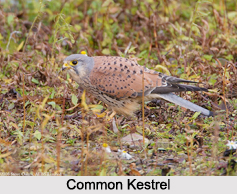 The Indian Subcontinent provides suitable habitats to various species of birds for residing and reproducing. Kestrels are no exception in this regard. Common Kestrel and Lesser Kestrel are the two kestrels which have been recorded in India. They belong to the kingdom, Animalia; phylum, Chordata; class, Aves; order, Falconiformes; family, Falconidae; and genus, Falco. These kestrels are described below.
The Indian Subcontinent provides suitable habitats to various species of birds for residing and reproducing. Kestrels are no exception in this regard. Common Kestrel and Lesser Kestrel are the two kestrels which have been recorded in India. They belong to the kingdom, Animalia; phylum, Chordata; class, Aves; order, Falconiformes; family, Falconidae; and genus, Falco. These kestrels are described below.
Common Kestrel
Common Kestrel is a small bird of prey. Its species name is F. Tinnunculus. More specifically, this kestrel can be traced on fields, heaths, shrub lands, wetlands, moorlands, arid savanna and marshland.
The male bird has light chestnut brown upperside and buff underside. The upperside of the bird has distinctive blackish spots, whereas narrow blackish streaks are present on the underside. The bird has grey-colored head and tail and bright yellow-colored cere, feet and narrow ring around the eye. Its bill, iris and toenails appear to be grayish black. As compared to the male kestrel, the female kestrel is slightly larger, has fewer black spots and streaks and a blue-grey cap and tail. A Common Kestrel depends on small mammals, particularly voles and other rodents and small birds for survival.
Lesser Kestrel
Lesser Kestrel is also a small bird of prey. Its species name is F. Naumanni. More specifically, this kestrel occupies steppe-like habitats, natural and managed grasslands, semi desert habitats and non-intensive cultivation.
The male bird has rusty brown upper body and buff lower body. There are black-colored spots present on the underside of the bird. The bird has a distinctive bluish grey head. Its tail is grey and has a subterminal black band on it. As compared to the male bird, the female is rusty on the back with black barring and streaking. It is slightly larger than the male and is devoid of the bluish grey head. As compared to the male Common Kestrel, the male Lesser Kestrel is devoid of the dark spotting on the back and has grey patches on the wings. The male Lesser Kestrel shares similar head and tail with the male Common Kestrel. Rather than the plumage, call and structure of the female and young birds help to separate them from their relatives. This bird depends on large insects like grasshoppers, locusts, crickets, tree frogs, small reptiles and small birds for survival.











